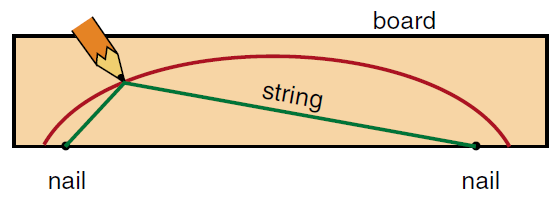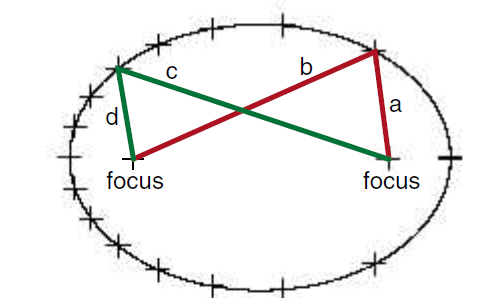Kepler's First Law
Kepler's first law states that the planets move in elliptical orbits with the sun at one focus. By analogy we should find from our Orbit 1 program that earth satellites move in elliptical orbits with the center of the earth at one focus. To check this prediction, we need to know how to construct an ellipse and determine where the focus is located.
The arch above the entrance to many of the old New England horse sheds was a section of an ellipse. The carpenters drew the curve by placing two nails on a wide board, attaching the ends of a string to each nail, and moving a pencil around while keeping the string taut as shown in Figure (1). The result is half an ellipse with a nail at each one of the focuses. (If you are in the Mormon Tabernacle’s elliptical auditorium and drop a pin at one focus, the pin drop can be heard at the other focus because the sound waves bouncing off the walls all travel the same distance and add up constructively at the second focus point.)

Figure 1: Ellipse constructed with two nails and a string.
To see if the satellite orbit from the Orbit 1 program is an ellipse, we first locate the second focus using by locating the point symmetrically across from the center of the earth as shown in Figure (2). Then at several points along the orbit we draw lines from that point to each focus as shown, and see if the total length of the lines (what would be the length of the stretched string) remains constant as we go around the orbit).

Figure 2: Checking that our satellite orbits are an ellipse. We construct a second focus, and then see if the sum of the distances from each focus to a point on the ellipse in the same for any point around the ellipse. For this diagram, we should show that a+b = c+d.
 الاكثر قراءة في مواضيع عامة في علم الفلك
الاكثر قراءة في مواضيع عامة في علم الفلك
 اخر الاخبار
اخر الاخبار
اخبار العتبة العباسية المقدسة


